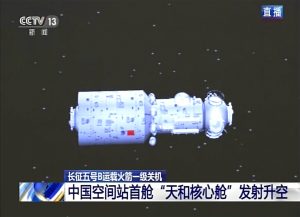On April 29, China completed yet another milestone in its ambitious and growing space program when it sent a core module of the space station it is building into outer space. Chinese news agency Xinhua reports that the module, called Tianhe, was carried to space using a Long March-5B Y2 rocket, which lifted off from the Wenchang Spacecraft Launch Site in Hainan province at 11:23 a.m. local time.
“Tianhe will act as the management and control hub of the space station Tiangong, meaning Heavenly Palace, with a node that could dock with up to three spacecraft at a time for short stays, or two for long,” the news agency quoted Bai Linhou, deputy chief designer of the space station at the China Academy of Space Technology (CAST), as saying.
China expects the Tiangong’s construction to be completed next year.
Xinhua notes that later this year, China will send two spacecraft – one of which will be manned – to dock with the Tianhe. The manned spacecraft, called Shenzhou-12, will carry three astronauts who will stay in orbit for six months, the news agency stated.
“In previous missions, we sent water and oxygen to space along with astronauts. But for a stay of three to six months, water and oxygen would stuff the cargo craft full with no room for other necessary goods and materials. So we installed the core module with a new life support system to recycle urine, exhaled breath condensate (EBC) and carbon dioxide,” Xinhua quoted Bai as noting.
China has launched two prototypes for its space station program so far: the Tiangong-1, which was in space between 2011 and 2018, and the Tiangong-2, in orbit between 2016 and 2019. Unlike the Tiangong-1, which crashed into the Pacific Ocean in 2018, Tiangong-2 was deliberately decommissioned in 2019 after it had completed a series of experiments.
China’s moves toward building its own space station come contemporaneously with the International Space Station (ISS) inching toward the end of its term in space. The first component of the ISS – the result of partnership between Canada, Japan, Russia, and the United States and countries that participate in the European Space Agency – was launched in 1998, and became operational in 2000, with NASA estimating its maximum longevity at 30 years with a minimum of 15 years. It obtained an extension to operate in space for another 10 years in 2014.
“While ISS is currently approved to operate through at least December 2024 by the international partner governments, from a technical standpoint, we have cleared ISS to fly until the end of 2028,” a November 2020 NASA statement to Space.com noted. “Additionally, our analysis has not identified any issues that would preclude us from extending beyond 2028 if needed.” However, experts believe that the end of the station’s time in space will come sooner than later as a variety of factors increase chances of accidents.
China was prohibited from participating in the ISS in 2011 following passage of a law by the U.S. Congress that forbids contact between Chinese and American space programs due to national security concerns.
On April 21, the head of the Russian space agency Roscosmos, Dmitry Rogozin, announced that Russia will be pulling out of the ISS in 2025. The ISS has two segments, one operated by the U.S. and the other by Russia. Announcing the decision, Rogozin noted to reporters, “It does not mean that the station will be scrapped and dumped into the ocean immediately after 2025. We will simply hand over the responsibility for our segment to the partners.” He also stated that a decision to launch a Russia-only space station now rests with Russian President Vladimir Putin.
On March 10, Roscosmos announced that it had entered into an agreement with China’s National Space Administration to build research facilities on the surface of the moon. According to the joint statement making the announcement, the International Scientific Lunar Station will be open for use by third nations. Following the launch of the Tianhe, a Xinhua commentary outlined ways in which China intends to allow international collaborations with the space station under construction.
In December last year, China’s Chang’e-5 became the first mission since 1976 to successfully collect and return lunar material to earth.

































